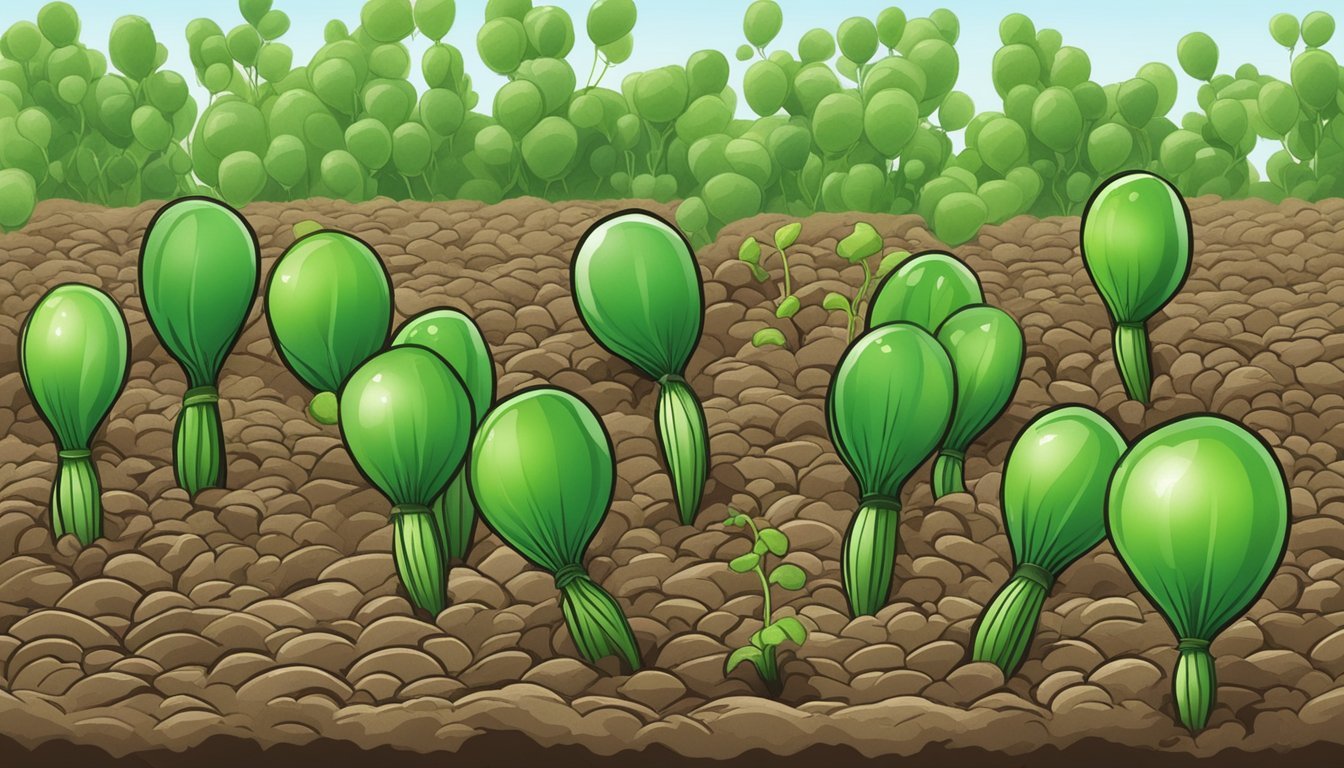Radish Pods Substitutes
Best Alternatives for Recipes
Sometimes, finding radish pods at the grocery store can be a challenge, and gardeners might not always have them fresh from the garden. Luckily, several excellent substitutes can replicate the crunchy texture and mild spiciness of radish pods. Options like jicama, daikon radish, or even the regular radish itself can be used to maintain the desired taste and consistency in your dishes.
Horseradish root, frequently found in various cuisines, offers a spicy kick similar to radish pods when prepared with salt and vinegar. For a milder flavor, consider parsnips or jicama. Their slightly sweet and nutty profiles provide a delightful crunch, making them suitable alternatives in salads and other recipes.
Experimenting with these substitutes can lead to discovering new flavors and improving traditional recipes. Using available ingredients creatively can ensure that missing radish pods does not mean missing out on delicious meals.
Understanding Radish Pods
Radish pods are the seed pods of the radish plant that form after the plant flowers. These pods resemble snap peas and can be harvested when they are young and tender.
The texture of radish pods is crunchy, similar to snap peas, and they carry a slightly spicy flavor reminiscent of the radish root.
Nutritional Benefits:
Rich in vitamins A, C, and K
Good source of fiber
Contains antioxidants
Usage:
Raw Consumption: Eat fresh radish pods straight from the plant or add them to salads for a crunchy bite.
Culinary: Pickled radish pods can be a tangy addition to dishes. Incorporate them in stir-fries, roast them, or add to curries.
Snacking: Enjoy them as a healthy snack.
To get radish pods, let the radish plant flower. The pods develop soon after fertilization and can be picked once they are around two to three inches long.
Recognizing radish pods as a versatile and nutritious part of the radish plant can offer innovative culinary possibilities while reducing waste.
Health Benefits of Radish Pods
Radish pods offer numerous health benefits due to their rich nutrient composition, antioxidant properties, and digestive health contributions. These pods are nutritious, packed with vitamins and minerals and provide valuable dietary fiber which supports digestive health. They also contain antioxidants that can help protect the body from oxidative stress.
Nutrient Richness
Radish pods are nutrient-dense, providing essential vitamins and minerals. Notably, they contain vitamin C, which helps boost the immune system and promotes skin health. Folate within radish pods aids in DNA synthesis and repair, which is crucial during periods of rapid growth such as pregnancy.
Magnesium and potassium are other significant minerals found in radish pods. Magnesium contributes to muscle and nerve function, while potassium helps maintain normal fluid balance and supports cardiovascular health. Additionally, radish pods also have small amounts of calcium, supporting bone health.
Antioxidant Properties
Radish pods are rich in antioxidants, which are compounds that help neutralize free radicals in the body. Free radicals are molecules that can cause cellular damage, leading to chronic diseases and aging. Antioxidants in radish pods include vitamin C and various organic acids.
These antioxidants not only protect against oxidative stress but also enhance the immune system. Antioxidant consumption through radish pods can contribute to reducing inflammation and may lower the risk of chronic conditions such as heart disease and cancer.
Dietary Fiber and Digestive Health
Dietary fiber present in radish pods plays a vital role in digestive health. Fiber helps add bulk to stools, which makes bowel movements easier and prevents constipation. This ensures a healthy and regular digestive process.
Moreover, adequate fiber intake from radish pods can aid in maintaining a healthy weight. Fiber-rich foods tend to be more filling, which can help in managing appetite and reducing overall calorie intake. Incorporating radish pods into the diet can support digestive health and contribute to overall well-being.
Culinary Uses of Radish Pods
Radish pods offer a unique flavor reminiscent of snap peas, making them versatile in various culinary settings, from fresh salads to cooked dishes and pickled preserves.
Fresh Applications
Radish pods can be enjoyed straight off the plant as a snack. Their crunchy texture and mildly spicy flavor make them a delightful addition to salads. Toss radish pods with greens, cucumbers, and a light vinaigrette for a refreshing salad.
They pair well with nuts and seeds, adding an interesting texture contrast. In sandwiches and wraps, they introduce a crisp element that complements softer ingredients like lettuce and tomatoes.
Cooked Presentations
Stir-frying radish pods brings out their sweetness while maintaining their crunch. They can be combined with proteins like chicken or tofu, and vegetables such as bell peppers and snap peas for a balanced side dish.
In curries and stews, radish pods impart a subtle, peppery note that melds well with aromatic spices. Roasting radish pods with olive oil, salt, and pepper also transforms them into a savory accompaniment.
Pickling and Preserving
Pickled radish pods provide a tangy, spicy burst of flavor. They can be pickled using a straightforward brine—vinegar, water, sugar, and salt. This method extends their shelf life, making them a versatile ingredient for various dishes.
Add them to sandwiches, wraps, or serve them as a zesty side dish. Preserving radish pods through pickling allows for a long-lasting and flavorful ingredient that can be used well beyond the radish season.
Selecting and Storing Radish Pods
Radish pods are a nutritious and low-calorie addition to many dishes.
When selecting radish pods, look for ones that are firm and vibrant in color. Soft or discolored pods may indicate they are not fresh.
Once harvested, radish pods should be cleaned thoroughly under running water to remove any dirt or debris.
To maximize their shelf life, store radish pods in an airtight container or a sealed plastic bag. They should then be placed in the refrigerator's crisper drawer where they can stay fresh for up to a week.
Tip: For prolonged storage, radish pods can be pickled or lightly steamed and then frozen.
Here's a handy table for quick reference:
Storage Duration Method Up to 1 week Refrigerate Several months Pickle or Freeze
Keeping radish pods fresh not only ensures their taste but also preserves their nutritional benefits.
Radish Pods Substitutes
When looking for alternatives to radish pods, both root and cruciferous vegetables offer viable substitutes. These options provide similar textures and flavors to enhance your dishes without compromising on taste or dietary balance.
Root Vegetable Substitutes
Jicama is a popular choice due to its crisp texture and sweet, nutty flavor. It can be used in salads or eaten raw, providing a similar crunch to radish pods. Ratio: 1:1.
Horseradish root adds a spicy kick to dishes, making it a potent substitute for radish pods when grated. Combine with salt and vinegar to mimic the radish flavor.
Parsnips offer a slightly sweet and earthy flavor with a similar crunchy texture. They can be eaten raw in salads or roasted. Though not as spicy, they blend well in mixed vegetable dishes.
Cruciferous Vegetable Substitutes
Kohlrabi is another excellent alternative, offering a mildly sweet, peppery flavor. When grated, it complements a variety of salads and slaws, much like radish pods.
Daikon radish provides a spicy yet milder flavor compared to traditional radish pods. This large, white root vegetable can be sliced or grated into dishes, offering a similar crunch.
Turnips, with their slightly peppery taste, serve as a reliable substitute for radish pods. They can be shredded or chopped into salads and provide a robust texture that withstands cooking.
Choosing Substitutes Based on Flavor Profiles
When substituting radish pods, it is crucial to select alternatives that match the desired flavor profile—be it mild, spicy, or earthy.
Mild Alternatives
Daikon Radish is an excellent choice due to its mild, slightly sweet taste. Originating from East Asia, it retains the crisp texture needed for most dishes.
Jicama offers a subtly sweet and nutty flavor, matching the crunchiness of radish pods when used raw in salads or slaws.
White Turnips are another suitable substitute; they have a mild, slightly sweet flavor and a firm texture that works well in both raw and cooked preparations.
Spicy Options
Horseradish brings a strong, spicy kick to dishes. Its intense flavor makes it suitable for those who prefer a more potent substitute.
Red Radishes, commonly found in supermarkets, offer a peppery taste that adds a punch to any recipe. They are often used in raw preparations to provide a peppery bite similar to radish pods.
Watermelon Radish not only offers a slightly spicy flavor but also adds visual appeal with its vibrant color. This makes it an attractive, yet spicy, addition to salads and garnishes.
Earthy Flavors
Kohlrabi provides a slightly sweeter and earthy flavor. It maintains a firm texture, making it a great substitute in recipes that require a substantial bite.
Black Radish is known for its deep, earthy flavor. It can be used in both cooked and raw dishes, although its strong taste is best balanced with milder ingredients.
Parsnips can serve as a substitute with their sweet, earthy flavor. They soften when cooked, making them suitable for soups and stews that traditionally use radish pods.
In summary, selecting the right radish pod substitute hinges on matching the specific flavor profile desired for the dish—whether mild, spicy, or earthy.
Vegetable Substitutes for Specific Dishes
Choosing the right vegetable substitutes can enhance the flavor and texture of your dishes, making them more appealing and delicious.
Salads and Cold Dishes
For salads and other cold dishes, jicama proves to be a fantastic alternative to radish pods. This root vegetable from Mexican cuisine offers a similar crisp texture with a sweet, nutty taste. It can be used in a 1:1 ratio, adding a refreshing crunch to your greens.
Kohlrabi also works well, particularly in slaws and raw salads. Its slightly sweeter flavor complements other ingredients without overpowering them.
Another excellent option is Daikon radish, which adds a mild, peppery note familiar to traditional radishes, perfect for enhancing cold dishes.
Cooked Meals and Sides
When preparing cooked meals and sides, the choice of substitute can significantly influence the dish's outcome. Parsnips serve as a notable substitute, offering a texture similar to radish pods, with a mild sweetness that pairs well with savory dishes. Best used roasted or in soups, parsnips add both flavor and a pleasing contrast.
Horseradish root, though more pungent, can be finely grated and used sparingly to mimic the spicy kick of radish pods in cooked dishes.
Additionally, Daikon radish holds its texture well when cooked, making it suitable for stir-fries and roasted vegetable medleys.
These substitutions ensure your meals retain complexity and depth while accommodating texture and flavor changes.
Substitute Vegetables Nutritional Comparison
When exploring alternatives to radish pods, the nutritional content of each substitute is crucial. Here, the nutritional profiles of several substitutes will be compared, focusing on nutrients such as fiber, vitamin C, potassium, antioxidant properties, calcium, and sodium.
Jicama
Fiber: 1 cup provides 6 grams of dietary fiber.
Vitamin C: High in vitamin C, with 1 cup offering 44% of the daily recommended intake.
Potassium: Contains around 195 milligrams per cup.
Antioxidant Properties: Known for its antioxidants, which may help protect cells from damage.
Calcium: Provides roughly 12 milligrams per cup.
Sodium: Very low in sodium, making it heart-friendly.
Kohlrabi
Fiber: Offers about 5 grams of dietary fiber per cup.
Vitamin C: Rich in vitamin C, with 1 cup offering 140% of the daily recommended intake.
Potassium: Contains approximately 473 milligrams per cup.
Antioxidant Properties: Contains phytochemicals with antioxidant benefits.
Calcium: Provides around 24 milligrams per cup.
Sodium: Similarly low in sodium, ideal for maintaining a low-sodium diet.
Watermelon Radish
Fiber: Contains about 2 grams of dietary fiber per cup.
Vitamin C: Offers around 20% of the daily recommended intake of vitamin C.
Potassium: Approximately 270 milligrams per cup.
Antioxidant Properties: Contains significant antioxidants that support overall health.
Calcium: Around 30 milligrams per cup.
Sodium: Low sodium content, similar to other radishes.
Horseradish
Fiber: Each tablespoon provides about 0.5 grams of fiber.
Vitamin C: High in vitamin C, perfect for boosting the immune system.
Potassium: Contains around 37 milligrams per tablespoon.
Antioxidant Properties: Rich in glucosinolates, which have antioxidant effects.
Calcium: Low in calcium.
Sodium: Can be high in sodium depending on preparation; fresh root is preferable for low sodium.
These comparisons highlight the nutritional diversity of each substitute, aiding in making informed choices for healthy cooking.








